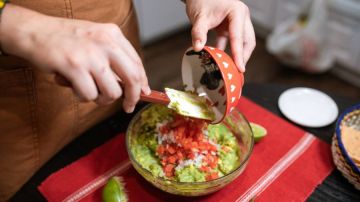Latin Food isn’t Unhealthy, Systemic Inequalities Are What’s Detrimental to Our Health
Krista Linares is a registered dietitian nutritionist and founder of Nutrition Con Sabor

Photo: RODNAE Productions/ Pexels
Krista Linares is a registered dietitian nutritionist and founder of Nutrition Con Sabor.
Latinxs in the U.S. face worse health outcomes than their non-Latinx white counterparts, including higher rates of diabetes and often times it’s our diet that gets the blame. It makes sense why people would think this — the primary public health messaging around preventing and managing chronic diseases like diabetes emphasizes what individuals can do such as diet changes, exercise, and stress management. The assumption is then that we would think there must be something about the Latin food that is driving these health outcomes.
Enter the wide variety of diet solutions aimed at our community –”healthy” versions of our comfort foods, dietary guidelines designed for non-Latinx consumers translated into Spanish. All of these “solutions” send Latinxs the same message — there’s something about our foods that is wrong and needs to be changed. It makes us think that knowledge of a healthy diet is something that we just don’t have, and that we need to be taught. Sit with that thought for a minute. Does it really make sense?
It’s more likely that the depiction of our food culture has been twisted to fit the narrative, to make the health disparities make sense and place the blame squarely on us instead of any of the factors that drive unequal health outcomes.
So if not our food culture, what really drives health inequalities? The truth is health is a class issue as well as an issue of systemic racism. Yes, food plays a role, but it’s more about the inequalities that drive our access to food than anything inherent about our cultural foods.
In fact, evidence shows that Mexican immigrants who maintained an eating pattern closer to a traditional Mexican diet had better health outcomes than those who assimilated more to American food culture. What are the factors that drive dietary assimilation? Lack of resources like time and money can make it difficult to maintain a heritage diet that is more labor intensive than the standard American diet, for one. It’s also hard to ignore the role that discrimination plays in driving pressure to assimilate.
It’s not just the way inequality shapes our food choices, either. Stress, which comes with income inequality, poverty, and lack of access to necessary resources, is also associated with chronic disease. Not to mention lack of access to healthcare, both by being uninsured or not having access to healthcare providers who speak your language or understand your culture, can interfere with Latinxs’ ability to manage their conditions or catch them early enough to intervene.
And yet, we are still mainly turning our eye to our food culture as the reason for our unequal health outcomes. In one focus group, Mexican American women between the ages of 18 and 29 had this to say about how they viewed healthy eating: “we are used to our traditional food that is not the healthiest and that’s what we were taught to cook.” Participants expressed that eating healthy meant having to learn to cook foods outside of their heritage foods they grew up with.
But what is the reality of Latin cuisine? Of course it varies from region to region but the actual point is every regional cuisine throughout the world has been able to nourish its people throughout history in a healthy manner. How do we make sense of this depiction of our food culture when so many of our heritage foods are the darlings of the health food world?
Beans have always been a staple for us, and for good reason–they provide fiber, protein and minerals–but in the non-Latinx world they’re facing a renaissance thanks to the rise of plant-based diets. Similarly, chia seeds, quinoa, and acai — all heritage foods from Latin America — have all been dubbed “superfoods” and have seen the resulting price spike.
But when describing the rates of chronic disease in the Latinx community, the frequent use of tomato, avocado, beans, and squash are rarely mentioned, even though all of these foods are health food superstars. Instead our food culture gets overgeneralized as “higher in fat and calories.” The truth about our food culture is that it provides a wide variety of grains, proteins, fruits and vegetables. And if you’re thinking, well what about pan dulce? Or plátanos maduros? First I want to remind you that these foods can fit quite easily into an overall healthful eating pattern. Our health is more about the overall patterns rather than an individual food. Next, remember that while the ingredients may be unique to our culture, the concept of sweets or fried foods are found in virtually every culture. Latin food does not have a uniquely high occurrence of these types of foods.
Our Latin food culture has so much to offer us and so much inherent wisdom in it, like how the way we process corn into masa increases the availability of certain vitamins, just to name one. And yet our food has become the scapegoat for the effects systemic inequality has had on us. While it’s true that our community faces worse health outcomes from diseases like diabetes, remember that rice, beans, and tortillas are not the culprit, but rather systemic inequalities that impede our access to food and healthcare.

















